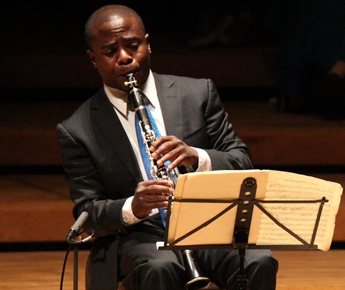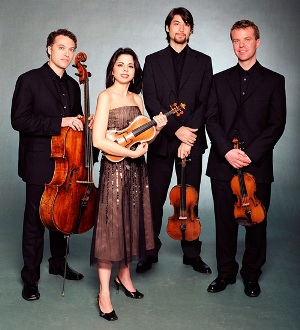Classical Music Review: Clarinetist McGill Thrills (with Pacifica Quartet)
It was an absolute pleasure to finally hear the extraordinary clarinetist Anthony McGill in person, and clearly the audience felt the same because there were several curtain calls and much cheering.
Pacifica Quartet with Anthony McGill clarinet. Presented by the Celebrity Series of Boston. At the Longy School of Music of Bard College, 27 Garden Street, Cambridge, MA Boston, MA, October 24.
By Susan Miron
Some performers so far exceed normal expectations that one experiences both complete amazement and sheer delight. These singers, dancers, actors, and musicians inevitably become legends. People who have heard or seen them know immediately that they are experiencing something they will, most likely, remember forever.
Such was my first experience hearing superstar clarinetist Anthony McGill, known perhaps as the fellow who played with YoYo Ma and Itzhak Perlman at Obama’s 2009 inauguration (on YouTube). Others might know he is principal clarinetist of the famed Metropolitan Opera Orchestra with a burgeoning career as soloist and chamber music player. He makes the clarinet sing with astonishing sweetness and power.
When Harold Wright, the legendary BSO clarinetist, died almost 20 years ago, I felt I’d never again hear a clarinetist with his gifts—superb musicianship, gorgeous sound throughout the three clarinet registers, the ability to make other players he was playing orchestral or chamber music with sound even better than they were.
McGill is the only clarinetist I’ve heard since who is the equal of Wright. His performance of the Mozart Clarinet Quintet (nicknamed “Stadler” after the clarinetist Mozart composed it for) with the Pacifica Quartet was enthralling and thrilling from the first notes. It was a pleasure to finally hear this extraordinary clarinetist in person, and clearly the audience felt the same, as there were several curtain calls and much cheering. What fabulous musicianship and what a gorgeous sound! Hear him on YouTube in the Met Orchestra with mezzo-soprano Susan Graham in “Parto parto.”
The concert’s second half was a different affair altogether. The quartet had performed well with Mr. McGill, with whom they have played before. Yet, despite this quartet’s considerable critical reputation, I was unimpressed by them during the second half. They played “Return,” a world premiere by Cambridge-based Keeril Makan, who introduced his piece. It’s a 13-minute, anxiety-themed work that Makan describes as “a mystery: trying to find a balance between the illusion that events repeat themselves, and the reality that nothing ever returns unaltered.” The mostly minimalist, edgy piece seemed suited to the quartet, who pride themselves as champions of contemporary music.
Intonation problems in the first violin were evident in the Mozart but glaringly so in the Beethoven String Quartet No. 14 in C-sharp minor, Op. 131. The monumental Beethoven, considered by the composer himself—as well as by Schubert and Wagner—to be his greatest quartet, is the fourth of his five final string quartets, written in the last year of his life. Consisting of seven continuous movements clocking in at around 40 minutes, the piece opens with a darkly somber fugue in C-sharp minor, a rarely used key before this (except for Bach). The second movement is a sunny, lyrical scherzo, while the fifth movement is a frenzied scherzo. The quartet did their best playing in these scherzos and tackling the last movement, with its skipping rhythm, a diabolical danse macabre. But other parts of the quartet received less than inspired playing, resulting in, alas, an uneven performance.
To these ears, Pacifica Quartet is a puzzle.They have won many of the important awards in the music business, but I am at a loss to explain why. The excellent cellist, Brandon Vamos, is its strongest and most sensitive player. The violist, Masumi Per Rostad, was good, but the other inner voice, second violinist Sibbi Bernhardsson, was often hard to hear. The problem, especially apparent in the Beethoven, was first violinist Simin Ganatra, whose often shrill quality and bad intonation were hard to listen to. I kept wondering why and how this quartet had such a stellar reputation—residencies at good music schools, tours galore. In this age of myriad glorious string quartets, it was disconcerting—I felt as if I was listening to a good student quartet. I would wish them luck, but they’ve already had plenty of that.
Susan Miron, a harpist, has been a book reviewer for over 30 years for a large variety of literary publications and newspapers. Her fields of expertise were East and Central European, Irish, and Israeli literature. Susan covers classical music for The Arts Fuse and The Boston Musical Intelligencer.



As a retired NYC professional violinist, I had the Guarneri Quartet series at the Met Museum for many years. On their retirement, they were replaced by the Pacifica Quartet. After their first season’s series, my wife and I canceled our long-standing Met subscription – the visual swaying and bad intonation and balance were more than we could stomach.
A young group – the Escher Quartet now on the artist roster of Lincoln Center’s Chamber Music Society – satisfies our requirements for excellent balance, intonation, tone quality and musicianship we so loved about the Guarneri.